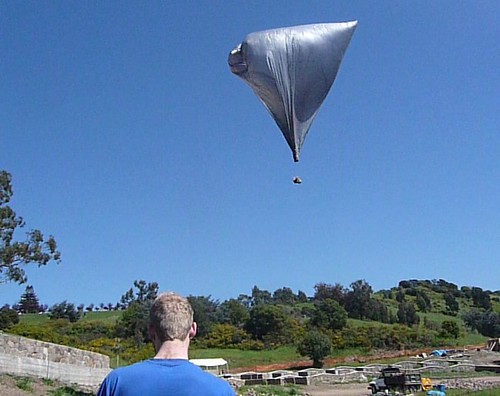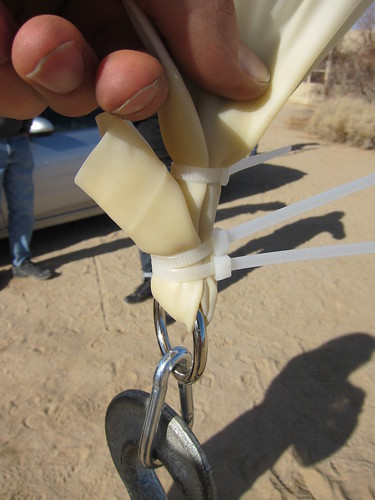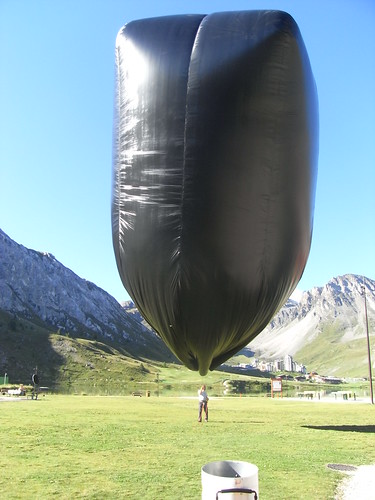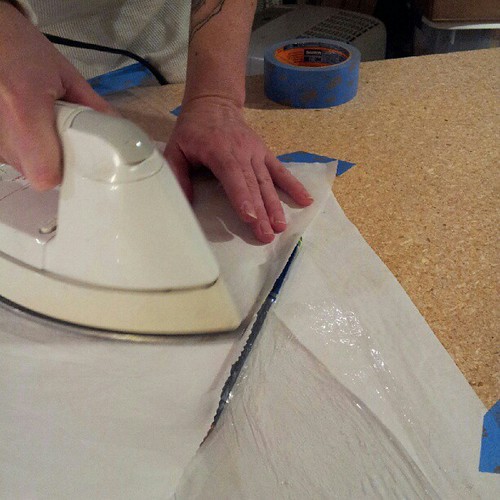Photo Credit: Matthew Coolidge
I've been flying solar hot air balloons since 2008 and thought I'd summarize some of my experiences here, since most of my work on them was before the PLOTS site. Here's my summary post to the grassroots mapping list back in October, 2010. Also attached is an annotated version of my solar balloon taping guide from 2009, with some good illustrations.
Here's a map I made with one back in January:
General thoughts on flying Solar hot air balloons are beautiful, fun, and really cheap (less than $5), but extremely wind sensitive and too big to fly legally above 300 feet (95 meters). They work great in deserts, tundra, and any place with lots of sun and without trees, buildings, wires, or many people.
Flying them on a line does not give one much control, and they will blow over to near horizontal in any amount of wind. a 12' (4 meter) balloon gets about 1kg spare lift. That's a lot of surface area with very little lift to keep it in place. I find 9-11AM, when the wind is usually calm but the sun pretty intense, to be the best time to fly. in order to get imagery, I look at the wind direction and pretty much let the balloon free float down wind over whatever I want to take pictures of. I then pull the balloon down, walk it up wind, and repeat.
In my attached guide, I discuss a quick deflation strategy that can be useful for free flying hot air balloons in more crowded areas. I've had mixed success using this strategy with balloons big enough to hold cameras.
Inspriration From Other People's Balloons Wikipedia has a good history of Solar balloons from the '70's. Laurence and Christophe Praturlon in France are the modern masters of DIY plastic solar balloons. Their site has great instructions. Christophe sells solar balloons for photography, albeit for a good chunk of change (he once quoted me over $800). His balloons are cylindrical. Here's a huge one for lifting a person:
The Praturlons use really thin .3-.4 mil black HDPE. I can't find that material regularly (some cheap garbage bags are made of that) and so I use .3 mil translucent HDPE drop cloth powder coated with pigment, following the recommendations of Robert Rochte. Robert was active on the now largely silent Yahoo Solar Balloons Group. The transparent film is definitely stronger and more durable, so I really prefer it.
Tetrahedron Balloons (tetroons)

I only make tetrahedron balloons (triangular pyramid), because they're really quick to tape up. I can make a 12 foot one by heat seaming in about 30-45 minutes or with tape in about an hour and a half. I generally make tetrahedron by folding from a rectangle with a ratio of sides 1 to the square root of 3, which is the ratio to make a platonic tetrahedron. I have calculated the volume of my balloon using Steve Griffin's guidelines. He also has a great hot air balloon lift calculator.
Steve says: The volume of a tetrahedron very closely approximates the volume of a cube with a side half the length of tetrahedron's side. eg. If your tetrahedron has a side of 6 metres then the volume will be (6/2)3 = 33 = 27m3
Raven Industries recommends (article attached) making a tetrahedron out of a rectangle with a ratio of sides 1:2.31. For this shape, they say the volume of an inflated tetrahedron balloon, is 0.26*h3 where h is the length of the longer side of the rectangle the balloon is to made out of. I don't really understand why a non-symmetrical shape is more valuable, but who knows, they're pros...
Materials Acquisition
As mentioned earlier, I use thin (.3 mil) HDPE "painters plastic," a 12 foot wide, 400 foot long roll costs about $25. I coat the inside with pigment, specifically Bayferrox iron oxide black 330. Bayferrox's distributor LanXESS is a very nice company that has mailed me several 1lb free samples over the years; I don't think they sell a bag less than 50lbs. This pigment was discovered in a group of samples Molly Danielsson brought me from the concrete factory where she works, and I'm very satisfied with it. James Lent and I have tried a range of pigments and this is the only really dark one..
Call LanXESS' Inorganic Pigments department, and be honest about what you're up to!
LanXESS Burgettstown 8 Morgan Road Burgettstown PA, 15021 412-809-4730
I roll out about 20'10" of plastic from a 12' roll to get the right ratio of sides, then I fold it in half length-wise, seal the two short sides, and then seal the long side at perpendicular to the length-wise fold, like this:
Heat seaming makes a lighter, stronger balloon, but tape is accessible and works very well:
Heat Seaming: this can be done just as well with a regular clothes iron -- no steam. I find it easiest to run the iron on its edge. A flat surface underneath is a must, and a long metal ruler works best. The hot iron melts the plastic towards the cool metal ruler, where it forms a nice bead.
Taping: I've annotated my old guide (2009) to folding and taping to correct info (attached below). If you want to tape a balloon, follow these instructions and save yourself the headache of figuring out how to line up the seams.
Pigmenting I clip open a corner of the balloon wide enough to inflate with a computer fan, and pour about half a cup of pigment into the balloon. Then, without inflating it and with the cut corner held closed, I work the pigment down and around, rubbing it all over the inside. I then pour out the excess. No matter what, you'll get a little dirty.
Inflating I make an inflation device that consists of a computer fan attached to two nine volt batteries in series. The fan I wrap with some cardboard to make a tube, and stick the tube into my balloon. It inflates in about 10 minutes, and heats up rapidly in the sun.
Sealing
Just use the same system of a ring and zip-ties Aurora Tang taught us to use to close helium balloons. it works great and is totally easy.





22 Comments
thanks for this. I wonder whether this would work in Louisiana marshes in the summer--lots of sun. May have to make multiple tether points for the wind, though.
Reply to this comment...
Log in to comment
This is so great. Mathew - how many flights is 1lb of pigment good for? I have the 1lb jar you gave me, will probably try it this summer, but am happy to ship anyone some amount of it if they like.
If this starts to really become popular, we could buy a 50lb bag and resell, i suppose. Do you happen to know the cost of the 50lb bag?
BTW I love that their product image on the pigment website is of a pigment molecule. Talk about open source... lol
Is this a question? Click here to post it to the Questions page.
Reply to this comment...
Log in to comment
The pigment doesn't really wear off and I don't have to re-coat the balloon between flights.
Next time I make one I'll have to weigh the balloon before and after coating, but my impression is that each balloon takes much less than an ounce of pigment. Volumetrically it only takes about a tablespoon. That said, its hard to coat the balloon unless its filled with a good quantity of pigment to work around; just throwing a tablespoon in doesn't work very well.
When Molly brought me the first pigment sample, it was less than a 4 volumetric ounces,, and that served to make 3 twelve foot balloons and 5 seven foot balloons, with some left over and about half of it recklessly spilled.
I'd bet that a pound could be divided into 20 or more packets each good for a few balloons.
Reply to this comment...
Log in to comment
The phone number for BayFerrox is updated to 800-526-9377.
Reply to this comment...
Log in to comment
Hi, This is really interesting. Do you know if you can fly solar ballons over New York City, or Staten Island? If so, are there height restrictions in this area (especially Staten Island)? Many thanks
Is this a question? Click here to post it to the Questions page.
Reply to this comment...
Log in to comment
the flight restrictions are going to be the same everywhere-- stay away from the airport and under 300 feet. These balloons ARE large enough to be regulated. be careful, and keep the local FAA number handy if it gets loose.
My comment above is not correct. Please check out the balloon regulation page.
Reply to this comment...
Log in to comment
Great set of instructions but ... the heat seaming video is sort of done from the wrong angle so you can't see what's happening. Any chance of posting one showing precisely where you put the iron? Do you put it on the metal rule and slide the rule down, or on the plastic directly? How long do you make contact?
I've tried melting plastic and just ended up making a mess. Heating the metal rule, the heat dissipated and had no impact on the plastic.
Guidance much appreciated.
:(
Is this a question? Click here to post it to the Questions page.
Reply to this comment...
Log in to comment
Directly onto plastic will get you a melted mess. Put down silicone parchment paper (for baking cookies) and use an iron on top of that. Use the tip or edge of the iron. I have good luck using irons sideways. If you need a protective surface underneath, try butcher paper. I'd start by turning the iron all the way up, and pressing hard into the plastic. The straight-edge/form is just a guide.
Reply to this comment...
Log in to comment
Updated link to Bayferrox pigment:
http://bayferrox.com/fileadmin/pdf/IPG/00672017_000_BF-330-ENG.pdf
Reply to this comment...
Log in to comment
Ramiro on the KAP forums has posted a whole system of spreadsheets and software for making spherical gores: http://arch.ced.berkeley.edu/kap/discuss/index.php?p=/discussion/5133/solar-balloon-how-to-go-from-txt-to-drawing
also, check out the Jake III from bovineaerospace. http://bovineaerospace.wordpress.com/2012/05/26/jake-iii-the-successful-launch-of-a-20-ft-solar-balloon/
Is this a question? Click here to post it to the Questions page.
Reply to this comment...
Log in to comment
more on heat seaming http://publiclab.org/notes/elainechoi89/8-3-2012/solar-balloon-heat-seaming-process
Reply to this comment...
Log in to comment
As a pigment, can we use charcoal as mentioned in the annotated kiss balloon pdf? As charcoal is easily available anywhere so i was hoping if i could use it? Has anyone tested with charcoal, do you recommend using charcoal?
Is this a question? Click here to post it to the Questions page.
Reply to this comment...
Log in to comment
Also what's the current progress in this solar heated balloons in public labs. I just came to know that it topic is 5 years ago.
Please share any progress, if any
Reply to this comment...
Log in to comment
Hi, @suman - this is a great question and I've had some not great experience using coarse charcoal briquettes (the balloon did not fly very strongly). But maybe vine charcoal or art charcoal would be better.
If you'd like to post this question to the whole community, try https://publiclab.org/questions
Reply to this comment...
Log in to comment
Hi Suman, I haven't really worked on solar hot air balloons for a while. Hot air balloons, and solar hot air balloons especially, are not great for flying on strings. They don't have enough lift to resist even the slightest wind. it is a good strategy for free flight balloons.
In terms of balloon fabrication I haven't seen any new developments, but the Aerocene project is making some great strides on flight prediction software: http://aerocene.org/
Pigment: A solar balloon doesn't need pigment to fly, but the pigment significantly increases solar absorption. Charcoal will work to get a pale grey color. it needs to be ground very finely. We did a series of tests back in 2010 of different pigments. The type of charcoal doesn't seem to matter much: https://groups.google.com/forum/#!topic/grassrootsmapping/qdzH9mnfUo0
One thing I haven't seen tried-- static charging either the balloon or the charcoal/carbon black particles. This has been suggested a few times. I'm not sure how to do that.
good luck! I hope to see you flying.
Reply to this comment...
Log in to comment
Hello Mathew,
Thanks for sharing some of your insights of solar heated balloons. I totally agree with you that wind is one of the major limitations. I have been working on the design to withstand the wind. My mission is to fly in the morning time usually (9-11 am ) which has normally less wind. Also, this time is also the best time for flights with an NDVI camera as the sun is nearly at Zenith.
I designed a model of solar heated balloon with payload of 100 gm which can embed Modified Mobius Action Cam. Regarding pigmenting, i have tried charcoal mixture which subsequently increased the solar absorption rate. Similarly, the rope configuration that i designed seems to be slightly more withstanding wind speed than the normal configuration. I will share the design in the public labs soon within a month as i have other deadlines coming very soon.
I too haven't tried static charging the balloons or charcoal but i would love to try it out. Can you share me some more contents on it.
My main vision behind solar heated balloons is to make a more scalable model that can be integrated to light weight action camera modified for infrared spectrum and together with automatic image recognition and image processing pipelines; provide a cheap affordable precision agriculture tool for farmers belonging to developing countries like Nepal, India, Tanzania, etc.
Lets keep in touch, share and make the discussion going.
I would like to apologize for my late response.
Best ,
Suman Ghimire
Nepal
Reply to this comment...
Log in to comment
Reply to this comment...
Log in to comment
beautiful flight @suman!
Reply to this comment...
Log in to comment
Hello, I know that this thread is quite inactive but maybe still someone with experience is hanging around. My question is about the mentioned problem on navigating the balloon in wind. I fully understand, that this is a problem having the balloon attached to just one line. What about attaching the balloon to three lines to keep the balloon in place? Spreading these three lines apart on the ground would limit the balloons movement in the horizontal. I understand, that this limits the possible height as distance of corners on the ground needs to be adjusted to the height but would that be possible? Or is the balloon changing height during winds, so it sinks rapidly? Do I miss something in my thoughts? Naturally three lines would add more load...
Thanks for any explanation!
Is this a question? Click here to post it to the Questions page.
Thom, A "tripod" of lines may help stabilize the balloon somewhat, and is a good idea.
However, the problem of balloon stability is not just about the lines, but also about the forces acting on the balloon, specifically the wind and the lift of the gas. A solar balloon has very limited gas lift for its volume, and a large surface area affected by the wind.
In practice, this means that even a very slight breeze (i.e. 2-3mph, 3-5kmh) can drive a tethered solar balloon to the ground. A solar balloon is best flown an an extremely still, windless and sunny day.
I will usually identify the slight breeze that exists and plan the travel path of the balloon around the breeze. I'll start on the windward side of the site and walk downwind with the balloon until the edge of my site is reached. Then I'll take the balloon down, move to a new upwind location, and repeat.
Reply to this comment...
Log in to comment
Hello, I know this thread is quite inactive but maybe someone with experience is still hanging around. I have a question regarding navigating the balloon during slight winds. Would it work to attach the balloon to three lines that are spread to a triangle at the ground to limit horizontal movement of the balloon? I know that this would add more load and limit possible heights as the spreading on the ground needs to be larger than the height but still.... Am I missing something in my thoughts?
Thank you for any explanation!
Is this a question? Click here to post it to the Questions page.
Reply to this comment...
Log in to comment
Login to comment.